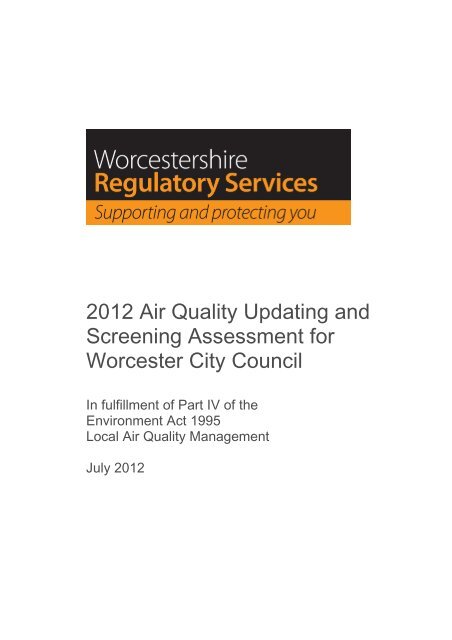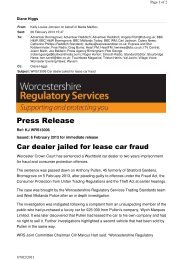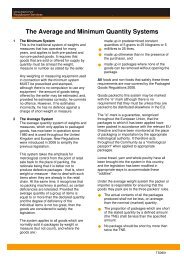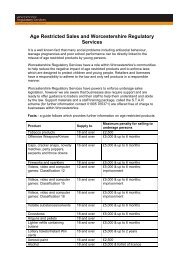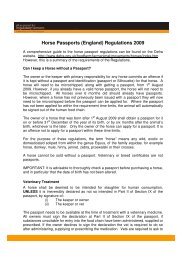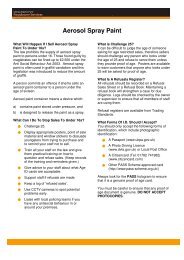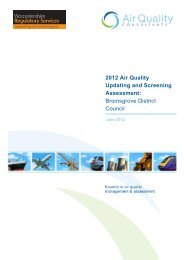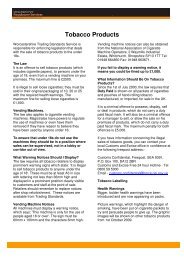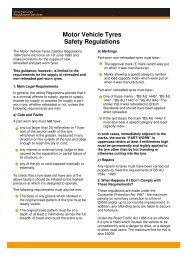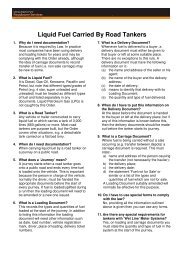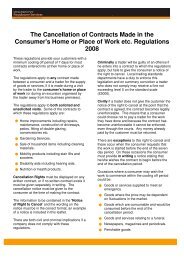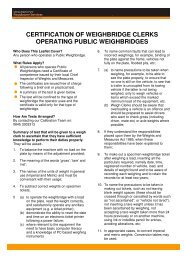Worcester City - Worcestershire Regulatory Services
Worcester City - Worcestershire Regulatory Services
Worcester City - Worcestershire Regulatory Services
Create successful ePaper yourself
Turn your PDF publications into a flip-book with our unique Google optimized e-Paper software.
<strong>Worcester</strong> <strong>City</strong> CouncilExecutive SummaryThis report presents the findings of <strong>Worcester</strong> <strong>City</strong> Council’s Updating and ScreeningAssessment (USA) of air quality within the city. The USA evaluates new and changedsources to identify those that may give rise to a risk of an exceedence of an airquality objective. Results from monitoring within the city are also presented andevaluated in relation to the objectives; the likelihood of an exceedence at relevantlocations is discussed, as is the requirement to proceed to a Detailed Assessment.Previous Review and Assessments have concluded that concentrations of carbonmonoxide, benzene, 1,3-butadiene, lead, sulphur dioxide and PM 10 are compliantwith the relevant objectives. Air Quality Management Areas (AQMAs) have howeverbeen declared at three locations for exceedences of the annual mean nitrogendioxide objective.Monitoring data for 2011 show that there is the risk of exceedences of the annualmean nitrogen dioxide objective at two locations representative of relevant exposureoutside of the existing AQMAs; these locations both lie within the <strong>City</strong> Wide AQMAwhich is currently under consultation.The USA has not identified any significant changes in emissions sources within the<strong>Worcester</strong> <strong>City</strong> Council area.LAQM USA 2012ii
<strong>Worcester</strong> <strong>City</strong> Council1 Introduction1.1 Description of Local Authority Area<strong>Worcester</strong> <strong>City</strong> is located in the West Midlands within the County of <strong>Worcester</strong>shire.To the south lies Gloucestershire, to the east Warwickshire, to the north areBirmingham and Shropshire and to the west lie the Malvern Hills. The M5 motorwayruns along the eastern and north-eastern boundaries of the <strong>City</strong>. The only industrialsource within the city is JVM Metal Castings on Droitwich Road, which has a permitfrom the Environment Agency.1.2 Purpose of ReportThis report fulfils the requirements of the Local Air Quality Management process asset out in Part IV of the Environment Act (1995), the Air Quality Strategy for England,Scotland, Wales and Northern Ireland 2007 and the relevant Policy and TechnicalGuidance documents. The LAQM process places an obligation on all local authoritiesto regularly review and assess air quality in their areas, and to determine whether ornot the air quality objectives are likely to be achieved. Where exceedences areconsidered likely, the local authority must then declare an Air Quality ManagementArea (AQMA) and prepare an Air Quality Action Plan (AQAP) setting out themeasures it intends to put in place in pursuit of the objectives.The objective of this Updating and Screening Assessment is to identify any mattersthat have changed which may lead to risk of an air quality objective being exceeded.A checklist approach and screening tools are used to identify significant new sourcesor changes and whether there is a need for a Detailed Assessment.1.3 Air Quality ObjectivesThe air quality objectives applicable to LAQM in England are set out in the Air Quality(England) Regulations 2000 (SI 928), The Air Quality (England) (Amendment)Regulations 2002 (SI 3043), and are shown in Table 1.1. This table shows theobjectives in units of microgrammes per cubic metre µg/m 3 (milligrammes per cubicmetre, mg/m 3 for carbon monoxide) with the number of exceedences in each yearthat are permitted (where applicable).LAQM USA 2012 1
<strong>Worcester</strong> <strong>City</strong> CouncilTable 1.1 Air Quality Objectives included in Regulations for the purpose ofLAQM in EnglandPollutantBenzeneAir Quality ObjectiveConcentration Measured as16.25µg/m 3Running annualmeanDate to be achievedby31.12.20035.0µg/m 3 Annual mean 31.12.20101,3-Butadiene 2.25µg/m 3 Running annualmeanCarbon monoxide 10.0mg/m 3 Running 8-hourmeanLeadNitrogen dioxideParticles (PM 10 )(gravimetric)Sulphur dioxide31.12.200331.12.20030.5µg/m 3 Annual mean 31.12.20040.25µg/m 3 Annual mean 31.12.2008200µg/m 3 not to beexceeded more than18 times a year1-hour mean 31.12.200540µg/m 3 Annual mean 31.12.200550µg/m 3 , not to beexceeded more than35 times a year24-hour mean 31.12.200440µg/m 3 Annual mean 31.12.2004350µg/m 3 , not to beexceeded more than24 times a year125µg/m 3 , not to beexceeded more than3 times a year266µg/m 3 , not to beexceeded more than35 times a year1-hour mean 31.12.200424-hour mean 31.12.200415-minute mean 31.12.2005LAQM USA 2012 2
<strong>Worcester</strong> <strong>City</strong> Council1.4 Summary of Previous Review and AssessmentsThe first and second rounds of Review and Assessment did not identify anyexceedences of the air quality objectives within <strong>Worcester</strong>.The 2007 Progress Report (<strong>Worcester</strong> <strong>City</strong> Council, 2007), however, identifiedpossible exceedences at the following diffusion tube monitoring locations:• Bridge Street/Dolday in the city centre;• Lowesmoor/Rainbow Hill (B4550);• A44 Whittington Road; and• B4636 Newtown Road.A Detailed Assessment was consequently undertaken in 2008 (<strong>Worcester</strong> <strong>City</strong>Council, 2008) which concluded that exceedences of the annual mean nitrogendioxide objective were likely at relevant locations adjacent to three of the fourmonitoring locations, with the exception being Whittington Road. Three Air QualityManagement Areas (AQMAs) were therefore declared at the following locations:• Bridge Street/Dolday;• Lowesmoor/Rainbow Hill; and• Newtown Road.Further Assessments of these AQMAs were completed in 2010 (<strong>Worcester</strong> <strong>City</strong>Council, 2010a). The conclusions were that:• The Bridge Street/Dolday AQMA should be extended slightly to includeadditional properties along Deansway;• The Lowesmoor/Rainbow Hill AQMA should be extended to include, as aminimum, all relevant locations to the north along Astwood Road; and• The Newtown Road AQMA should be revoked.The 2009 Updating and Screening Assessment (<strong>Worcester</strong> <strong>City</strong> Council, 2009)identified potential exceedences of the annual mean nitrogen dioxide in the St Johnsarea of the city. A Detailed Assessment was completed in 2010, which concludedthat an AQMA should be declared. The 2010 Progress Report (<strong>Worcester</strong> <strong>City</strong>Council, 2010b) also identified the need to progress to a Detailed Assessment fornitrogen dioxide at the Foregate Street/Shaw Street junction. A consultation hasrecently been carried out regarding the declaration of a <strong>City</strong> Wide AQMA, whichwould encompass both these areas, with a final decision to be made in November2012.LAQM USA 2012 3
<strong>Worcester</strong> <strong>City</strong> CouncilShould the decision be made to declare a <strong>City</strong> Wide AQMA, it will not be necessaryto carry out an additional Detailed Assessment, and instead a Further Assessmentwill be carried out to inform the Action Plan. A Steering Group is currently being setup to develop the Action Plan once the decision has been made.If a <strong>City</strong> Wide AQMA is not considered appropriate, additional AQMAs / DetailedAssessments will be prepared as necessary.The 2011 Progress Report did not identify any additional areas or sources requiringconsideration.Figure 1.1 Current AQMA BoundariesContains Ordnance Survey data © Crown copyright and database right [2012]LAQM USA 2012 4
<strong>Worcester</strong> <strong>City</strong> Council2 New Monitoring Data2.1 Summary of Monitoring Undertaken2.1.1 Automatic Monitoring Sites<strong>Worcester</strong> <strong>City</strong> Council operated an automatic monitoring station at Dolday in the citycentre from 2006 until 2008. Data capture was low and therefore the site closed in2008; there are currently no automatic monitoring sites within the <strong>Worcester</strong> <strong>City</strong>area.2.1.2 Non-Automatic Monitoring SitesDuring 2011, <strong>Worcester</strong> <strong>City</strong> Council monitored annual mean nitrogen dioxideconcentrations using passive diffusion tubes at seventeen locations across its area(Figure 2.1). Table 2.1 provides details of each of the monitoring sites, along withdetails of sites which have been discontinued in recent years but for which data areavailable.The diffusion tubes are prepared and analysed by Gradko using the 20% TEA inwater method. Tubes are changed on a monthly basis. Further details of the diffusiontube QA/QC is presented in Appendix A. More detailed maps are provided inAppendix B.LAQM USA 2012 5
<strong>Worcester</strong> <strong>City</strong> CouncilFigure 2.1 Non-Automatic Monitoring SitesContains Ordnance Survey data © Crown copyright and database right [2012]LAQM USA 2012 6
<strong>Worcester</strong> <strong>City</strong> CouncilTable 2.1 Details of Nitrogen Dioxide Diffusion Tube Monitoring SitesSite NameSite TypeX OS GridReferenceY OS GridReferenceInAQMA?RelevantExposure?Distance to kerbof nearest roadDoes this locationrepresent worst-caseexposure?Bridge Street Roadside 384666 254818 Y Y(5m) 1m YBromwich Road Kerbside 383990 252838 N Y(20m) 1m YKing Charles Place Kerbside 384016 254399 N Y(1m) 1m YMcIntrye Road Urban Background 383454 254606 N Y(8m) 1m n/aHenwick Road Kerbside 383826 255612 N Y(15m) 1m YAmbirack Roadside 384651 254978 N Y(30m) 1m YCastle Street Roadside 384804 255426 N Y(6m) 1m NDroitwich Road Kerbside 385385 258017 N N 2m YBilford Road Kerbside 385043 257223 N N 1m YWindermere Drive Kerbside 387229 256756 N Y(13m) 2m YAstwood Road (original) Urban Background 386068 256535 N N 1m n/aAstwood Road 1 Kerbside 386064 256518 N N 1m YAstwood Road 2 Kerbside 385994 256376 Y Y(4m) 2m YLowesmoor Estate Kerbside 385226 255166 Y N n/a NLowesmoor Crossing Kerbside 385141 255414 Y Y(6m) 1m YPlantation Drive Kerbside 388377 256336 N Y(20m) 1m YLarkhill Road Roadside 386131 254058 N Y(10m) 1m YWhittington Road Kerbside 387512 252845 N Y(20m) 5m YAbbotsbury Court Kerbside 386086 252697 N N 1m YKetch Roadside 385270 251667 N N 5m NBath Road Kerbside 385464 253245 N N 1m YSidbury Kerbside 385162 254441 N N 1m YBarbourne Road Roadside 384609 256144 N N 3m YNewtown Road 1 Kerbside 387908 254961 Y N 1m YNewtown Road 2 Kerbside 387069 255102 Y N 2m YSt Johns Kerbside 384070 254482 N N 2m YNewtown Road Kerbside 387801 254987 Y Y(10m) 1m YAstwood Road 3 Kerbside 385764 255968 Y Y(6m) 1m YSt Martins Gate Kerbside 384246 254932 N N 1m NGuildhall Urban Background 385164 240647 N N n/a n/aForegate St Kerbside 384941 255140 N Y(1m) 2m YLowesmoor 1 Kerbside 385268 255191 Y Y(1m) 1m YLowesmoor 2 Roadside 385164 255134 Y Y(2m) 2m YLAQM USA 2012 7
2.2 Comparison of Monitoring Results with AQObjectives2.2.1 Nitrogen DioxideDiffusion Tube Monitoring Data<strong>Worcester</strong> <strong>City</strong> CouncilMeasured concentrations at the 17 diffusion tube monitoring sites in 2011 arepresented in Table 2.2. Concentrations since 2006, at all sites where monitoring dataare available, are presented in Table 2.3.Data capture for a number of the diffusion tube sites was below 75%, and these datahave been annualised following guidance in LAQM.TG(09). Further details arepresented in Appendix A. The national bias adjustment factor has been applied to thediffusion tube data. Further details are provided in Appendix A.Exceedences of the annual mean objective were measured at seven sites during2011, four of which are outside of existing AQMAs.The sites measuring exceedences outside of the existing AQMAs are:• Castle Street• Sidbury• St Johns• Foregate StreetThe Castle Street diffusion tube has measured exceedences of the annual meanobjective since 2009. The closest relevant exposure is approximately 5m from themonitoring site. Using the fall off with distance calculator, an estimate of theconcentration at the façade of the closest property can be made. In 2011, theestimated concentration at the closest property is 32.7µg/m 3 . From May 2012, thistube has been relocated to the façade of 925 The Tything, where residentialexposure exists at first floor level.The Sidbury site is not representative of relevant exposure, as it is located in themiddle of the road. This tube will be relocated to more accurately represent relevantexposure. From May 2012, three new tubes have been deployed on London Roadwhere it meets Sidbury. Data will be reported in the 2013 Progress Report.The need for an AQMA at the St Johns site was identified in the 2010 DetailedAssessment, and an AQMA will be declared at this location pending the outcome ofthe decision to be taken by <strong>Worcester</strong> <strong>City</strong> Council, following the consultationregarding the declaration of a <strong>City</strong> Wide AQMA, in November 2012.LAQM USA 2012 8
<strong>Worcester</strong> <strong>City</strong> CouncilThe Foregate Street diffusion tube is located within 1m of relevant exposure, and hasmeasured concentrations well in excess of the annual mean objective. A DetailedAssessment at this location is on hold, pending the outcome of the consultationregarding the declaration of a <strong>City</strong> Wide AQMA, which is soon to be concluded.Concentrations continue to exceed the annual mean objective within the BridgeStreet/Dolday and Lowesmoor/Rainbow Hill AQMAs; in the Newtown Road AQMA,there have not been any measured exceedences since 2007, supporting the findingsof the 2010 Further Assessment and the intention to revoke this AQMA.Concentrations have reduced in 2011 relative to 2010 concentrations at all but onemonitoring location. Figure 2.2 presents data for those sites where at least five yearsof data are available. Overall, between 2006 and 2011, concentrations haveremained fairly stable at all long-term sites, excluding Castle Street, where there wasa significant increase between 2008 and 2009.LAQM USA 2012 9
<strong>Worcester</strong> <strong>City</strong> CouncilTable 2.2 Results of Nitrogen Dioxide Diffusion Tubes in 2011 (Bias Adjusted)Site Name Site Type Within AQMA?Data 2011 Annual Mean ConcentrationCapture (Months)(µg/m 3 ) aBridge Street Roadside Y 10 38.4King Charles Place Kerbside N 10 37.4McIntrye Road Urban Background N 12 16.4Ambirack Roadside N 12 38.4 bCastle Street Roadside N 9 42.7Astwood Road 1 Kerbside N 12 32.0Astwood Road 2 Kerbside Y 12 40.8Whittington Road Kerbside N 12 39.9Bath Road Kerbside N 10 29.1Sidbury Kerbside N 12 47.6Barbourne Road Roadside N 9 36.3Newtown Road 1 Kerbside Y 7 33.6St Johns Kerbside N 12 43.7Astwood Road 3 Kerbside Y 7 50.6Foregate St Kerbside N 11 53.2Lowesmoor 1 Kerbside Y 10 44.1Lowesmoor 2 Roadside Y 11 37.4Objective 40a Where data capture is less than 9 months, the concentration presented has been annualised. See Appendix A for further details.b Average of two co-located tubes.LAQM USA 2012 10
Table 2.3 Results of Nitrogen Dioxide Diffusion Tubes, 2006 to 2011 (Bias Adjusted)<strong>Worcester</strong> <strong>City</strong> CouncilSite NameSite TypeInAQMA?Annual Mean Concentration (µg/m 3 )2006 [0.98] 2007 [0.89] 2008 [0.92] 2009 [0.90] 2010 [0.92] 2011 [0.89]Bridge Street Roadside Y 48.0 46.6 46.6 39.9 46.5 38.4Bromwich Road Kerbside N 27.3 25.6 35.0 26.8 - -King Charles Place Kerbside N 44.1 42.3 42.8 42.6 40.9 37.4McIntrye RoadUrbanNBackground18.3 19.1 17.5 15.9 18.3 16.4Henwick Road Kerbside N 20.6 21.3 21.3 22.3 - -Ambirack Roadside N 42.3 37.0 38.2 39.3 41.5 38.4Castle Street Roadside N 30.2 28.3 30.0 42.4 48.9 42.7Droitwich Road Kerbside N 22.7 24.7 24.8 22.7 - -Bilford Road Kerbside N 31.4 30.6 31.9 28.9 - -Windermere Drive Kerbside N 35.9 33.9 29.3 40.2 - -Astwood RoadUrbanN(original)Background18.9 19.5 21.4 - - -Astwood Road 1 Kerbside N - - - 33.4 33.5 32.0Astwood Road 2 Kerbside Y - - - 39.4 37.6 40.8Lowesmoor Estate Kerbside Y 40.6 28.7 36.3 - - -Lowesmoor Crossing Kerbside Y 58.3 66.7 62.0 - - -Plantation Drive Kerbside N 26.6 28.0 26.2 39.0 - -Larkhill Road Roadside N 34.0 33.4 33.1 31.2 - -Whittington Road Kerbside N 44.2 45.9 45.2 43.7 44.0 39.9Abbotsbury Court Kerbside N 23.7 24.1 24.1 20.7 - -Ketch Roadside N 28.1 34.9 31.6 28.3 - -Bath Road Kerbside N 27.0 28.7 26.4 28.8 34.9 29.1Sidbury Kerbside N 55.6 57.2 56.8 52.1 58.7 47.6Barbourne Road Roadside N - - - 39.8 39.2 36.3Newtown Road 1 Kerbside Y - - - 32.3 37.9 33.6Newtown Road 2 Kerbside Y - - - 24.5 32.0 -St Johns Kerbside N - - - 44.4 48.8 43.7Newtown Road Kerbside Y - 41.4 34.7 - - -Astwood Road 3 Kerbside Y - 54.0 58.4 56.0 60.4 50.6St Martins Gate Kerbside N 45.8 41.4 42.3 - - -GuildhallUrbanNBackground22.4 22.3 20.9 - - -Foregate St Kerbside N - - - 57.0 55.7 53.2Lowesmoor 1 Kerbside Y - - - 42.9 48.8 44.1Lowesmoor 2 Roadside Y - - - 33.6 39.3 37.4Objective 40 40 40 40 40 40LAQM USA 2012 11
<strong>Worcester</strong> <strong>City</strong> CouncilFigure 2.2 Trends in Annual Mean Nitrogen Dioxide Concentrations measured at Diffusion Tube Sites in <strong>Worcester</strong> <strong>City</strong>LAQM USA 2012 12
<strong>Worcester</strong> <strong>City</strong> Council2.2.2 PM 10PM 10 is not monitored within the <strong>Worcester</strong> <strong>City</strong> Council area.2.2.3 Sulphur DioxideSulphur Dioxide is not monitored within the <strong>Worcester</strong> <strong>City</strong> Council area.2.2.4 BenzeneBenzene is not monitored within the <strong>Worcester</strong> <strong>City</strong> Council area.2.2.5 Other pollutants monitoredNo other pollutants are monitored within the <strong>Worcester</strong> <strong>City</strong> Council area.LAQM USA 2012 13
<strong>Worcester</strong> <strong>City</strong> Council2.2.6 Summary of Compliance with AQS Objectives<strong>Worcester</strong> <strong>City</strong> Council has examined the results from monitoring within the city.Concentrations outside of the existing AQMAs are below the objectives at locationsof relevant exposure, apart from at St Johns and Foregate Street. These locationshave been previously identified as requiring an AQMA / Detailed Assessment. Shoulda <strong>City</strong> Wide AQMA be declared following consultation in June 2012, the sites will beencompassed in the new AQMA. Should the <strong>City</strong> Wide AQMA not be declared, anAQMA will be declared at St Johns consistent with the findings of the 2010 DA, and aDA will be carried out for Foregate Street.LAQM USA 2012 14
<strong>Worcester</strong> <strong>City</strong> Council3 Road Traffic Sources3.1 Narrow Congested Streets with ResidentialProperties Close to the KerbBridge Street has been identified within previous Review and Assessment reports asmeeting the criteria for narrow congested streets. This location lies within the BridgeStreet/Dolday AQMA. No additional narrow congested streets have been identified orcreated within the <strong>Worcester</strong> CC area.<strong>Worcester</strong> <strong>City</strong> Council confirms that there are no new/newly identified congestedstreets with a flow above 5,000 vehicles per day and residential properties close tothe kerb, that have not been adequately considered in previous rounds of Reviewand Assessment.3.2 Busy Streets Where People May Spend 1-hour orMore Close to TrafficThe criteria for assessing busy streets relevant for the hourly nitrogen dioxideobjective are set out in Section A.2 of Box 5.3, LAQM.TG(09) and are unchangedfrom previous rounds of Review and Assessment. Busy streets where people mayspend 1-hour or more close to traffic were considered in previous Updating andScreening Assessments, and no new locations have subsequently been identified.<strong>Worcester</strong> <strong>City</strong> Council confirms that there are no new/newly identified busy streetswhere people may spend 1 hour or more close to traffic.3.3 Roads with a High Flow of Buses and/or HGVs.The criteria for assessing roads with high flows of buses and/ or HGVs are set out inSection A.3 of Box 5.3, LAQM.TG(09) and are unchanged from previous rounds ofReview and Assessment. Roads with high flows of buses and/or HGVs wereconsidered in previous Updating and Screening Assessments, and no new locationshave subsequently been identified.<strong>Worcester</strong> <strong>City</strong> Council confirms that there are no new/newly identified roads withhigh flows of buses/HGVs.LAQM USA 2012 15
<strong>Worcester</strong> <strong>City</strong> Council3.2 Bus and Coach StationsThe criteria for assessing bus and coach stations are set out in Section A.7 of Box5.3, LAQM.TG(09). Previous Updating and Screening Assessments have concludedthat there are no bus stations within the <strong>City</strong> with more than 2,500 daily movementsor with relevant exposure within 10m; the largest bus station in the city centregenerates approximately 600 movements per day. <strong>Worcester</strong> <strong>City</strong> Council hasconfirmed that there have been no significant changes.<strong>Worcester</strong> <strong>City</strong> Council confirms that there are no relevant bus stations in the LocalAuthority area.LAQM USA 2012 17
<strong>Worcester</strong> <strong>City</strong> Council4 Other Transport Sources4.1 AirportsThe criteria for assessing airports are set out in Section B.1 of Box 5.4,LAQM.TG(09). There are no airports within the <strong>Worcester</strong> <strong>City</strong> area.<strong>Worcester</strong> <strong>City</strong> Council confirms that there are no airports in the Local Authority area.4.2 Railways (Diesel and Steam Trains)The criteria for assessing railways (diesel and steam trains) are set out in Section B.2of Box 5.4, LAQM.TG(09).4.2.1 Stationary TrainsThe 2009 Updating and Screening Assessment did not identify any locations wherediesel locomotives were stationary for more than 15 minutes on a regular basis.There has been no change to this position.<strong>Worcester</strong> <strong>City</strong> Council confirms that there are no locations where diesel or steamtrains are regularly stationary for periods of 15 minutes or more, with potential forrelevant exposure within 15m.4.2.2 Moving TrainsNone of the rail lines identified in Table 5.1 of LAQM.TG(09) as carrying largenumbers of movements of diesel locomotives travel through <strong>Worcester</strong>.<strong>Worcester</strong> <strong>City</strong> Council confirms that there are no locations with a large number ofmovements of diesel locomotives, and potential long-term relevant exposure within30m.LAQM USA 2012 18
Opis mikrolokacijeGornji Horizonti predstavlja područje geotektonski izdvojeno kraškim poljima u IstočnojHercegovini, koji se nalazi na razvođu voda između rijeka Neretve i Trebišnjice i to u vidukaskadnih polja koja će biti međusobno povezani hidrotehničkim sistemom tunela i kanala.Predmetno područje pripada izuzetno razvijenom dinarskom holo karstu, hidrografska mreža jeveoma slabo razvijena, većina površina se drenira vertikalno putem škarpa, vrtača i podzemnihkarstnih kanala. Čitavo područje karakterišu brojni izvori, vrela, ponori i estavele, suve doline ikraška polja, koja su duže ili kraće vremana plavljena. Objekti hidroenergetskog sistema Dabarse nalaze na teritoriji opština Nevesinje, Berkovići i Bileća .Nevesinjsko polje je kraško polje na nadmorskoj visini 850-900 mnm, pruža se pravcemseverozapad-jugoistok na dužini od 24 km, širine 8,5 km i zahvata površinu od 170 km 2 . Poljese sastoji iz manjih polja Slato, Lukavac, Trusina, Morina i Zovidolsko polje na jugu. Okruženoje planinama Velež, Sniježnica, Crvanj, Visoravni Morine, Bjelašnica i Babe.Nevesinjskim poljem teče rijeka Zalomka, čija je hidrografska mreža najrazvijenija unajnizvodnijem delu, gde se ulivaju i najveće pritoke Zovidolka, Drežanjka i Bukovik sa lijeve iniz manjih pritoka sa desne strane. Rijeka Zalomka je karstni vodotok sa dugim bezvodnimperiodima i velikim poplavnim vodama, neizvjesnim granicama sliva, brojnim ponorima i vrelimaduž korita. Svoj površinski tok Zalomka završava u ponoru Biograd na koti približno 800 mnm.Rijeka Zalomka kao i čitav sliv Nevesinjskog polja preko vrela na Buni i Bunici drenira se uNeretvu.Specifičan položaj Dinarskih visokoplaninskih vjenaca, koji sprečavaju prodor maritimnih uticaja,kao i otvorenost prema planinskom području na sjeveru, uslovljava kretanje podneblja odumjerenokontinentalne do kontinentalne klime u visokoj Hercegovini. Ljeta su suva i relativnotopla, jeseni su toplije od proljeća, zime su duge i vrlo hladne, naročito su izražena godišnjatemperaturna kolebanja u kraškim poljima. Prosječne godišnje padavine su dosta ujednačene ikreću se od 1.500-2.000 mm. Dominira maritimni gaovice, u rijeci Zalomci i pritokama mogu sesresti razne vrste rakova i žaba.Na razmatranom području analiziranog hidroenergetskog sistema Dabar nema zaštićenihprirodnih dobara i zaštićenih prirodnih vrijednosti.Osnovne socioekonomske karakteristike područjaZbog izrazito surovih uslova života područje na kome se planira gradnja HE Dabar je u prošlomvijeku bi u stalnom procesu raseljavanja. Imajući to u vidu, područje Istočne Hercegovine spadau red privredno nerazvijenih područja u BiH, a na osnovu Prostornog plana Republike Srpskedo 2015. godine opština Nevesinje pripada izrazito nerazvijenom području kao i opštineBerkovići i Bileća.Dok je u posleratnom periodu (1948-1991. godine) bila prisutna stalna tendencija smanjenjastanovništva opštine Nevesinje, u periodu 1991-2006. godine zbog doseljavanja izbjeglica izokolnih područja Bosne i Hercegovine dolazi do porasta stanovništva. Po poslednjemslužbenom popisu stanovništva iz 1991. godine, opština Nevesinje je imala 14.448 stanovnika,a sam grad Nevesinje 4.068 stanovnika, dok je 2006. godine u opštini živelo 19.969 stanovnika.Istovremeno na ruralnom području opštine zabilježeni su negativni demografski trendovi, koji surezultat negativnog prirodnog priraštaja i neprekidnog iseljavanja u opštinske i regionalne centreu bližoj i daljoj okolini. Broj stanovnika 1991. godine u seoskim naseljima opštine Nevesinje,koja se nalaze na teritoriji sistema Dabar je iznosio: Budisavlje 99, Biograd 507, Rast 153, DonjiStudija uticaja projekta HE „Dabar“ na životnu sredinu24
<strong>Worcester</strong> <strong>City</strong> Council5 Industrial Sources5.1 Industrial Installations5.1.1 New or Proposed Installations for which an Air Quality Assessmenthas been Carried OutThe criteria for assessing industrial installations are set out in Section C.1 of Box 5.5,LAQM.TG(09) and are unchanged from previous rounds of Review and Assessment.There have been no new industrial installations within the <strong>Worcester</strong> <strong>City</strong> Councilarea since the 2009 USA was completed, and there are currently no proposals forany significant installations.<strong>Worcester</strong> <strong>City</strong> Council confirms that there are no new or proposed industrialinstallations for which planning approval has been granted within its area.5.1.2 Existing Installations where Emissions have Increased Substantiallyor New Relevant Exposure has been Introduced<strong>Worcester</strong> <strong>City</strong> Council is not aware of any industrial installations which havesignificantly increased their emissions, and no new exposure has been introducednearby to any existing installations. Data provided by the Environment Agency for theperiod 2008 to 2010 confirms that there were no significant changes to emissionsfrom Part A installations which they regulate within the <strong>Worcester</strong>shire area.<strong>Worcester</strong> <strong>City</strong> Council confirms that there are no industrial installations withsubstantially increased emissions or new relevant exposure in their vicinity within itsarea or nearby in a neighbouring authority.5.1.3 New or Significantly Changed Installations with No Previous AirQuality AssessmentThere have been no new industrial installations within the <strong>Worcester</strong> <strong>City</strong> Councilarea since the 2009 USA was completed, and there are currently no proposals forany significant installations.LAQM USA 2012 20
<strong>Worcester</strong> <strong>City</strong> Council<strong>Worcester</strong> <strong>City</strong> Council confirms that there are no new or proposed industrialinstallations for which planning approval has been granted within its area or nearby ina neighbouring authority.5.2 Major Fuel (Petrol) Storage DepotsThe criteria for assessing major fuel (petrol) storage depots are set out in Section C.2of Box 5.5, LAQM.TG(09) and are unchanged from previous rounds of Review andAssessment. Previous Review and Assessment reports have not identified any majorfuel storage depots; <strong>Worcester</strong> <strong>City</strong> Council has confirmed that this continues to bethe case.<strong>Worcester</strong> <strong>City</strong> Council confirms that there are no major fuel (petrol) storage depotswithin the Local Authority area.5.3 Petrol StationsThe criteria for assessing petrol stations are set out in Section C.3 of Box 5.5,LAQM.TG(09) and are unchanged from previous rounds of Review and Assessment.<strong>Worcester</strong> <strong>City</strong> Council confirmed in the 2009 USA that there are no petrol stationsnext to busy roads with more than 30,000 vehicles per day. Since then, no new petrolstations have been installed.<strong>Worcester</strong> <strong>City</strong> Council confirms that there are no petrol stations meeting thespecified criteria.5.4 Poultry FarmsThe criteria for assessing poultry farms are set out in Section C.4 of Box 5.5,LAQM.TG(09); this was a new consideration for the 2009 Updating and ScreeningAssessment. The 2009 USA stated that there were no poultry farms within the city;this position remains unchanged.<strong>Worcester</strong> <strong>City</strong> Council confirms that there are no poultry farms within the <strong>Worcester</strong><strong>City</strong> area.LAQM USA 2012 21
<strong>Worcester</strong> <strong>City</strong> Council6 Commercial and Domestic Sources6.1 Biomass Combustion – Individual InstallationsThe criteria for assessing biomass combustion (individual installations) are set out inSection D.1a of Box 5.8, LAQM.TG(09). Since the 2009 USA, a biomass boiler hasbeen installed at Fort Royal Primary School. An additional boiler is proposed for TheHive (new County Library), in the city centre, adjacent to the Dolday AQMA.The biomass calculator 1 was used to calculate the target emission rates for the twobiomass boilers. The boiler data used are presented in Table 6.1, whilst thecalculated Target Emission Rates are presented in Table 6.2. Backgroundconcentrations have been taken from the national maps provided on the UK-Airwebsite 2 .The emission rates do not exceed the Target Emission Rates for nitrogen dioxide orPM 10 , and therefore it is not necessary to proceed to a Detailed Assessment foreither biomass boiler.Table 6.1 Boiler Data used in the Screening AssessmentBoilerLocationBuildingHeight(m)StackDiameter(m)StackHeight (m)BackgroundConcentration(µg/m 3 )Emission Rates(g/s)PM 10 NO 2 PM 10 NO 2Fort Royal 9.7 0.3 10.8 15.6 17.9 0.002 0.011The Hive 5.4 0.4 19.1 14.8 13.3 0.070 0.025Table 6.2 Target Emission Rates from Biomass CalculatorBoilerLocationPM 10 Daily MeanTargetEmissionRate (g/s)DetailedAssessmentRequired?Nitrogen Dioxide AnnualTargetEmissionRate (g/s)MeanDetailedAssessmentRequired?Nitrogen Dioxide HourlyTargetEmissionRate (g/s)MeanDetailedAssessmentRequired?Fort Royal 0.0136 No 0.0541 No 0.0322 NoThe Hive 0.3543 No 1.6067 No 1.1183 No<strong>Worcester</strong> <strong>City</strong> Council has assessed the biomass combustion plant, and concludedthat it will not be necessary to proceed to a Detailed Assessment.1 Available at: http://laqm.defra.gov.uk/documents/biomass_calculator_tool6.xls2http://uk-air.defra.gov.uk/LAQM USA 2012 22
<strong>Worcester</strong> <strong>City</strong> Council6.2 Biomass Combustion – Combined ImpactsThe criteria for assessing biomass combustion (combined impacts) are set out inSection D.1b of Box 5.8, LAQM.TG(09). The estimated average PM 10 backgroundconcentration in <strong>Worcester</strong> in 2012 is 15.2µg/m 3 (range 13.7 – 18.7µg/m 3 ).Using the nomograms provided in TG(09) and data provided in Table 5.3, andassuming a worst-case background of 19µg/m 3 in a small town, emissions of at least6000 kg PM 10 per year would be required in a square 500m by 500m in order for thistype of emission source to be likely to lead to exceedence of the UK daily meanobjective for PM 10 . This is equivalent to over 200 households within a 500m by 500mgrid square all burning wood in fireplaces as their primary fuel. Alternatively, therewould need to be a minimum of 26,350m 2 of commercial floorspace (approximatelyequivalent to 10 large supermarkets) heated by biomass boilers within a 500m by500m grid square all using wood as their primary fuel. Using this fact, and thefindings of previous Review and Assessment reports, it is considered highly unlikelythat there are any areas of biomass combustion exceeding these criteria.<strong>Worcester</strong> <strong>City</strong> Council confirms that there are unlikely to be combined impacts frombiomass combustion in the Local Authority area.6.3 Domestic Solid-Fuel BurningThe criteria for assessing domestic solid-fuel burning are set out in Section D.2 ofBox 5.8, LAQM.TG(09) and are unchanged from previous Review and Assessments.The 2009 USA concluded that there were no areas of significant domestic coal orsmokeless fuel burning. There has not been a significant increase in domestic solidfuelburning.<strong>Worcester</strong> <strong>City</strong> Council confirms that there are no areas of significant domestic fueluse in the Local Authority area.LAQM USA 2012 23
<strong>Worcester</strong> <strong>City</strong> Council8 Conclusions and Proposed Actions8.1 Conclusions from New Monitoring DataTwo monitoring sites representing relevant exposure outside of existing AQMAs havemeasured exceedences of the annual mean nitrogen dioxide objective in 2011.These locations have been previously identified, and lie within the <strong>City</strong> Wide AQMAproposed. A consultation on the adoption of a <strong>City</strong> Wide AQMA is currentlyunderway. Depending on the outcome of the consultation, these sites will either liewithin the newly declared <strong>City</strong> Wide AQMA, or in line with recent findings, an AQMAwill be declared for the St Johns area and a Detailed Assessment will be carried outfor the Foregate Street area.The Sidbury site is not representative of relevant exposure, as it is located in themiddle of the road. This tube will be relocated to a more representative location.8.2 Conclusions from Assessment of SourcesThe Updating and Screening Assessment has not identified any significant changesto emissions sources within the <strong>Worcester</strong> <strong>City</strong> Council area that will lead to adeterioration in air quality. There have been no new or significantly altered industrialprocesses, road, transport, commercial, domestic or fugitive sources of emissions forwhich more Detailed Assessment is required.8.3 Proposed ActionsOnce a decision is made following the consultation into the <strong>City</strong> Wide AQMA, either a<strong>City</strong> Wide AQMA will be declared and a Further Assessment completed, or an AQMAwill be declared in the St Johns area and a Detailed Assessment will be carried outfor Foregate Street.Consideration will be given to relocating the Sidbury diffusion tube.A Progress Report will be submitted to Defra in April 2013.LAQM USA 2012 25
<strong>Worcester</strong> <strong>City</strong> Council9 ReferencesDefra (2009) Review & Assessment: Technical Guidance LAQM.TG(09), available at:http://archive.defra.gov.uk/environment/quality/air/airquality/local/guidance/documents/tech-guidance-laqm-tg-09.pdfDefra (2012) Data Archive, available at: http://uk-air.defra.gov.uk/data/<strong>Worcester</strong> <strong>City</strong> Council (2007). Air Quality Progress Report 2007. Available at:www.worcester.gov.uk/fileadmin/assets/pdf/Environment/Environmental_health/Air_Quality/<strong>Worcester</strong>_<strong>City</strong>_Council_PR07_FINAL.pdf<strong>Worcester</strong> <strong>City</strong> Council (2008). Detailed Assessment 2008. Available at:www.worcester.gov.uk/fileadmin/assets/pdf/Environment/Environmental_health/Air_Quality/<strong>Worcester</strong>_DA_-_Final.pdf<strong>Worcester</strong> <strong>City</strong> Council (2009). 2009 Updating and Screening Assessment,<strong>Worcester</strong> <strong>City</strong> Council, June 2009.<strong>Worcester</strong> <strong>City</strong> Council (2010a). Detailed Assessment of Air Quality at St. Johns andFurther Assessment of Air Quality in the Bridge Street/Dolday, Lowesmoor/RainbowHill and Newtown Road: <strong>Worcester</strong> <strong>City</strong> Council, August 2010.<strong>Worcester</strong> <strong>City</strong> Council (2010b). Progress Report 2010: <strong>Worcester</strong> <strong>City</strong> Council, July2010.<strong>Worcester</strong> <strong>City</strong> Council (2011). Progress Report 2011: <strong>Worcester</strong> <strong>City</strong> Council,January 2012.LAQM USA 2012 26
<strong>Worcester</strong> <strong>City</strong> CouncilAppendicesAppendix A: QA/QC of Diffusion Tube DataAppendix B: Maps of Diffusion Tube Monitoring SitesLAQM USA 2012 27
Appendix A: QA/QC of Diffusion Tube Data<strong>Worcester</strong> <strong>City</strong> CouncilDiffusion Tube Bias Adjustment FactorsThe national bias adjustment factor for diffusion tubes supplied and analysed byGradko, 20% TEA in water for 2011 is 0.89. This factor is taken from spreadsheetversion 03/12, and is based on 26 studies.WASPGradko take part in the Workplace Analysis Scheme for Proficiency (WASP),operated by the Health and Safety Laboratory (HSL). During 2011, on average,84.4% of samples were determined to have been satisfactory (1st quarter: 100%;2nd quarter: 100%; 3rd quarter: 100%, 4th quarter: 37.5%).Short-term to Long-term Data Adjustment (Annualisation)Where diffusion tubes were lost during the year, resulting in less than 9 months ofdata, the resulting period mean is not directly comparable to the objective. Therefore,in accordance with the guidance set out in Box 3.2 of LAQM.TG(09), the data havebeen adjusted to an annual mean, based on the ratio of concentrations during theshort-term monitoring period to those over the 2011 calendar year. This has utiliseddata from five background sites operated as part of the Automatic Urban and RuralNetwork (AURN) where long-term data are available.The annual mean nitrogen dioxide concentrations and the period means for each ofthe five monitoring sites from which adjustment factors have been calculated arepresented in the tables below, along with the Ratio applied.Feb – April, July, Sept – Nov (Astwood Road 3)Site Site Type Annual Mean Period Mean RatioAston HillRuralBackground5.2 6.3 0.821Birmingham UrbanTyburn Background34.4 36.0 0.955Coventry UrbanMemorial Park Background17.2 19.0 0.904Leamington UrbanSpa Background21.1 21.3 0.987LeominsterSuburbanBackground9.6 11.0 0.867Average 0.907LAQM USA 2012 28
<strong>Worcester</strong> <strong>City</strong> CouncilApril – May, Aug – Dec (Newtown Road 1)Site Site Type Annual Mean Period Mean RatioAston HillRuralBackground5.2 4.6 1.128Birmingham UrbanTyburn Background34.4 29.1 1.182Coventry UrbanMemorial Park Background17.2 15.8 1.089Leamington UrbanSpa Background21.1 19.5 1.077LeominsterSuburbanBackground9.6 8.0 1.198Average 1.135LAQM USA 2012 29
Appendix B: Maps of Diffusion Tube Monitoring Sites<strong>Worcester</strong> <strong>City</strong> CouncilContains Ordnance Survey data © Crown copyright and database right [2012]LAQM USA 2012 30
<strong>Worcester</strong> <strong>City</strong> CouncilContains Ordnance Survey data © Crown copyright and database right [2012]LAQM USA 2012 31
<strong>Worcester</strong> <strong>City</strong> CouncilContains Ordnance Survey data © Crown copyright and database right [2012]LAQM USA 2012 32
<strong>Worcester</strong> <strong>City</strong> CouncilContains Ordnance Survey data © Crown copyright and database right [2012]LAQM USA 2012 33


